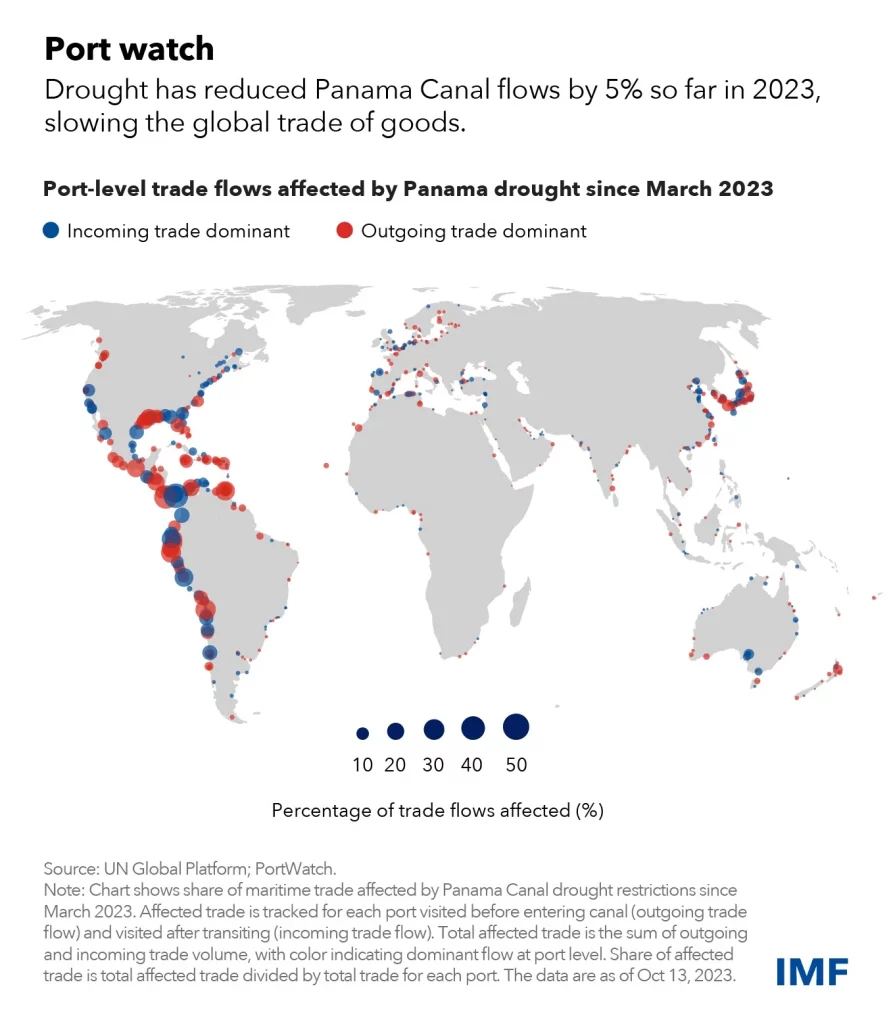The recent blog from the International Monetary Fund (IMF) has highlighted climate change’s grave implications for global trade. Specifically, it draws attention to an acute issue: The Panama Canal, a linchpin in connecting the Atlantic and Pacific oceans, currently grapples with its worst drought period exceeding over one century. This situation generates significant hurdles for international trade flow.
On average, the canal facilitates the passage of roughly 1,000 vessels per month. These vessels cumulatively transport upwards of 40 million tons of cargo, a significant slice representing about 5 percent of all maritime trade. The drought has led to a critical drop in water levels in Gatún Lake, an essential component of the canal’s infrastructure. This has triggered a sharp decrease in capacity, resulting in a reduction of capacity by approximately 15 million tons this year, and imposing longer transit times on shipping.
The ramifications of this are most acutely felt in the ports of Panama, Nicaragua, Ecuador, Peru, El Salvador, and Jamaica, with trade flow interruptions ranging from 10% to a substantial 25%. However, the crisis is not limited to this geographic area; its effects ripple out to continents far and wide, impacting trade as far afield as Asia, Europe, and North America. The projection for the canal is a reduction to a mere 18 ships per day by February from the typical 36, signaling ongoing and significant trade hindrances.

Accompanying this analysis is the “Port watch” infographic which visually maps the extensive impact of the Panama Canal drought on international commerce. It illustrates a 5 percent decline in maritime traffic through the canal in 2023 alone, severely affecting the global distribution of goods. Ports worldwide are marked with dots, color-coded to indicate the predominance of either inbound (blue) or outbound (red) trade, their size corresponding to the percentage of trade affected since Mar 2023. Data up to Oct 13, 2023, is included, showing some ports grappling with up to half of their trade flow being disrupted, underscoring the reliance of the world’s trade on the functioning of the Panama Canal
These disruptions, spreading globally, confirm the fragility of international trade networks when confronted with local climate events. The infographic, a potent visual representation, underlines how pivotal points such as the Panama Canal can trigger profound effects; it exposes vulnerabilities within global supply chains and emphasizes an urgent call for collective action to bolster defenses against these perils. There is no mistaking the implication—the repercussions of climate change defy borders and impact economic structures on a global scale.
Launching ‘PortWatch’
In a proactive move the IMF has joined forces with the University of Oxford to initiate PortWatch. This forward-thinking platform harnesses real-time satellite imagery to surveil nearly 120,000 maritime vessels, accounting for over 99% of the global sea trade. It assesses daily trading volumes across 1,400 ports, including key locations such as the Panama Canal. PortWatch also provides predictive climate scenario planning and dispatches timely warnings of potential trade interruptions following major disasters. This initiative is pivotal in equipping policymakers with the tools necessary to navigate and manage the trade repercussions of climate-related disruptions effectively.
As we confront the escalating effects of climate change, the Panama Canal situation serves as a stark reminder of our global trade system’s fragility and the urgent need for strategic, anticipatory measures to protect against future risks.
***
Source: Climate Change is Disrupting Global Trade by Serkan Arslanalp, Robin Koepke, Alessandra Sozzi, Jasper Verschuur, first published as IMF Blog. Read the original article.











